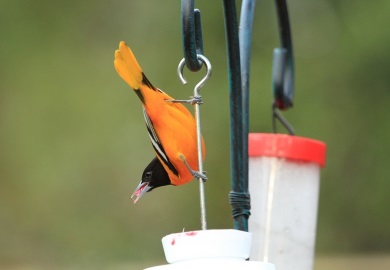May 3, 2019

Adult male Baltimore oriole visiting a feeder in Charleston. If you have these birds coming to your feeders during the winter, SCDNR wants to hear from you! (Photo by Russell Johnson)
South Carolina’s 2019 Baltimore Oriole Winter Survey reported the largest number of orioles wintering in the United States for the fifth year in a row.
Those results were recorded during the fifth annual Baltimore Oriole Winter Survey, conducted by the South Carolina Department of Natural Resources (SCDNR) Feb. 15-18, 2019. SCDNR’s survey was held in conjunction with the Great Backyard Bird Count (GBBC). Tapping into this longstanding citizen-scientist project allowed SCDNR to get a better picture of the status and distribution of this beautiful songbird wintering in the Palmetto State.
Survey participants in South Carolina submitted 84 reports and recorded 460 orioles. The number of reports was our highest number to date and the number of orioles recorded was just a few short of our all-time high count of 463, reported in 2016. The number of participants this year was a little less than half of our total number of participants and almost half of the participants this year were new contributors to the survey. Milder weather was in place again this year, and many survey participants commented they had larger numbers of orioles earlier in the winter, when the weather was more seasonal. Unseasonal mild weather likely reduces the need for these birds to frequent feeders, while they forage for natural foods.
Participants counted and reported the largest number of orioles they could see at one time, on one, two, three or all four days of the survey period. When possible, the age and sex of the orioles were recorded as well. Participants were also encouraged to report the absence of orioles, when they have had them in past winters and the largest number they have seen at one time so far, during the winter months, (December, January and February). Six sites that had previously report orioles in the past reported no orioles during the survey. Reporting the absence of orioles is just as important to the survey as the number of orioles seen.
This year, orioles were reported from 14 of the 20 South Carolina counties that have been reported to date. York County had a report for the first time during the survey. Orioles ranged from the Midlands and throughout the coastal plain, from North Myrtle Beach to Hilton Head. Charleston County had the most reports and recorded the largest number of orioles, reporting 38 percent of the total number of orioles in the state. Dorchester and Berkeley counties reported good numbers as well.
According to the GBBC and the SCDNR survey, there were a total of 270 reports and 926 orioles recorded this year in the United States. These numbers are above the last five-year average. South Carolina had the largest number of reports and orioles reported, 31 percent of the reports and 50 percent of the orioles reported. Orioles were noted from Connecticut to Florida and along the Gulf coast to Mississippi.
Baltimore Orioles are neotropical migrants, normally wintering in South and Central America and migrating to North America to nest. During the last few decades, however, this species has begun wintering annually in the Southeast. Though scientists are not sure why these birds have begun overwintering in growing numbers, the birds respond well to the popularity of backyard bird feeding. Orioles by nature have a “sweet tooth” and will eat nectar from flowers, wild fruits and insects. Their favorite bird-feeding food by far is grape jelly. Orange halves can be offered, but most orioles tend not to eat them much. People often put oranges out to attract the orioles to the feeding area. Other items orioles will eat are suet products (homemade, cakes, bark butter, logs, etc.), sugar water (they will drink from hummingbird or oriole nectar feeders), seed mixes (seem to prefer nut and fruit mixes), sliced grapes and mealworms (live or freeze-dried).
“We would like to thank everyone that participated in the survey,” said Lex Glover, wildlife technician with the SCDNR Bird Conservation Program. “Your time and efforts are greatly appreciated.”
Next year’s survey and Great Backyard Bird Count will be Feb. 14-17, 2020. If you have orioles frequenting your feeders during the winter months, (December, January and February), or know someone who does, SCDNR would like for you to participate in the survey. For more information on this survey or to receive this year’s survey results, contact Lex Glover at gloverl@dnr.sc.gov. For more information on the Great Backyard Bird Count, check out its web page at https://gbbc.birdcount.org/.



